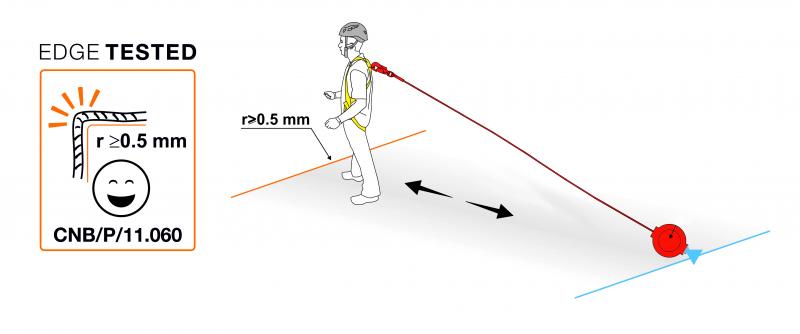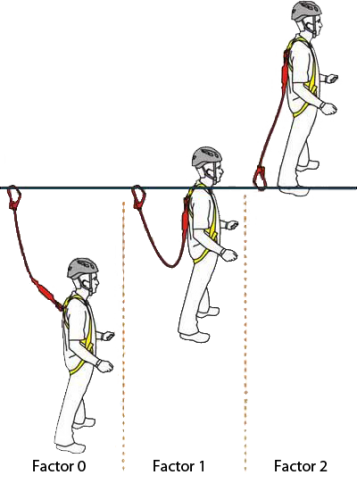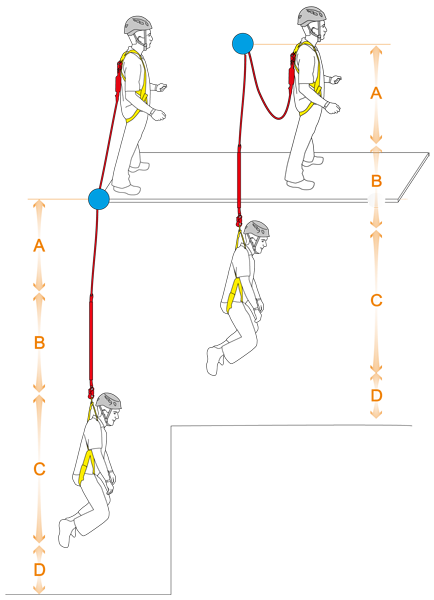- Total 0,00 SEK
Pendulum effect
Make sure your anchor point is properly placed! When a pendulum fall occur there is a high risk of falling to the underlying level or swinging into something. In addition, it is a high risk that the rope is cut over the edge. An anchor point placed in the corner, 2.5 meters in, significantly reduces the risk of a pendulum fall.

Sharp edges
It is very dangerous to work where there is a risk of cutting the lanyard over an edge if a fall occur! When using fall arrest equipment horizontally, specially certified products are required that are approved for horizontal use and sharp edges.

The EN standards do not prescribe test methods for sharp edges. So the group of coordination of notified bodies for fall arrest (VG11) found a way to test the horizontal/inclined use over sharp edge.
- EN 360 - Fall arrest block
CNB/P/11.060: test method for sharp edges with an edge radius greater than 0.5mm.
CNB/P/11.054: test method for very sharp edges with an edge radius less than 0,5mm. - EN 355 - Fall arrest lanyard
CNB/P/11.074: test method for sharp edges with an edge radius greater than 0.5mm. - EN 353-2 - Guided type fall arrester
CNB/P/11.075: test method for sharp edges with an edge radius greater than 0.5mm.
Fall factor
Fall Factor is a rating used to evaluate the danger of specific scenarios when working at heights.
Fall Factor is calculated using the following equation: Fall Factor = Height of Fall / Length of Lanyard
In situations where the Fall Factor will be 0 (e.g. the worker is positioned under the anchor point on a tensioned lanyard) or in situations where the Fall Factor is 1 or less and the freedom of movement is limited to 0.6 m or less, positioning equipment is adequate (i.e. EN 354 - EN 358). Fall arrest equipment with energy absorbing function must be used for any other situations where the Fall Factor is greater than 1 or more freedom of movement is required.

- Fall factor 0
The anchor point is above the worker. - Fall factor 1
The anchor point is in shoulder level. - Fall factor 2
The anchor point is at feet level.
Clearance distance
Fall arrest equipment requires a certain amount of space below the user to be able to brake in case of a fall. The clearance distance differs considerably between fall factor and type of equipment. The manufacturer states in the manual of each product how to calculate the clearance distance.
Pay close attention to the following precautions when using Fall Arrest Equipment:
- Fall arrest lanyards must not exceed 2 meters in length (including connectors); the maximum length for the Fall arrest lanyard Limited is 1.5 m.
- The length of a potential fall must always be minimized with the proper gear and rigging.
- The possibility of a worker hitting something during a fall must be eliminated.
- Avoid creating a Fall Factor greater than 2.
In the example below we have calculated the clearance distance from the location of the anchor point, that is, how far from the anchor point you will actually fall. In the example below, we used a standard 2 meter long fall arrest lanyard EN 355 connected to an anchor point with fall factor 2 and fall factor 1. Note that the manufacturer states in the manual of each product how to calculate the clearance distance.

- Length of fall arrest lanyard: 2 meters.
- Energy absorber extension: 1.6 meters.
- Distance between harness attachment and worker's feet: 1.5 meters.
- Safe distance from the ground: 1 meters.
Fall factor 2
Clearance distance = 6.1 meters.
- Length of fall arrest lanyard: 2 meters.
- Energy absorber extension: 0,9 meters.
- Distance between harness attachment and worker's feet: 1.5 meters.
- Safe distance from the ground: 1 meters.
Fall factor 1
Clearance distance = 5.4 meters.
Suspension Syncope or Trauma
Is it dangerous to be hanging in a harness?
It is very dangerous to hang immobile in a harness. Rescue should be carried out as quickly as possible. Deaths have occurred during training.
How does it work?
The heart pumps oxygen-rich blood to the body through the blood veins. Through the veins the blood flows back to the heart. The veins are provided with flaps that guide the blood in the right direction. As we move, our muscles put pressure on the veins that help the heart to pump back the blood.
When the heart is positioned higher than the legs, it requires muscle work to transport the blood in the legs back to the heart. If this does not work, then more and more blood will accumulate in the legs. This in turn leads to reduced blood volume in the rest of the body and brain. The decreased blood volume leads to poor blood circulation and we pass out. An example: A person who stands completely still for a long time passes out and falls, but immediately wakes up when in horizontal position. Then the blood flows around the body as usual again. But if you hang vertically in a harness and pass out, you will not wake up. The situation deteriorates for every minute that goes.
Important knowledge
- Try out your harness properly so that it feels comfortable to hang in.
- Regardless of the type of harness it is very dangerous to hang immobile.
- It is especially dangerous if you become unconscious.
- An injured person who is immovable on a stretcher that is lifted with the head end first is also at risk.
- Dizziness, nausea and difficulty breathing may be a symptoms of pre-syncope.
- Actions should be taken immediately to move the person to a non-hanging position.
- Workers at height should avoid long tough climbing on ropes when they are tired, dehydrated or cold.
- Work involving long periods hanging in the harness without support for the legs or the ability to move them should be avoided.
- Frequent "pumping" with the legs, activates the muscles, reduces the accumulation of blood in these and can prevent fainting.
- If possible, people who are conscious but not have the ability to pump their legs place them in horizontal position or raise their knees.
Rescue and treatment
The rescue of a person hanging in his harness must go fast. It is therefore very important that you have rescue training for situations that can occur.
The following should considered when rescuing and treating people with a possible Suspension syncope:
- Keeping the victim hanging can be more dangerous than the fall itself.
- It is very important to encourage the hanging person to move his legs.
Basic measures:
- The basic measures for trauma (ABCDE) must be followed.
- Medical services should be summoned immediately.
- Do not raise the upper body of a fainted or unconscious person.
- The injured person should be rescued from his hanging position as soon as possible.
- During rescue, the injured legs should be held high.
- Vertical lifting should be avoided or kept as short as possible.
- The injured person should not be left unattended.
- A tight harness or clothing must be released.
- Be aware of the risk of death after rescue, despite the absence of visible damage, the injured is in great danger.
Source: HSE (Health & Safety Executive), Health and Safety Laboratory and University of Birmingham, 2009 "Evidence-based review of the current guidance on first aid measures for suspension trauma" (RR708 Research report). Download the report here.

